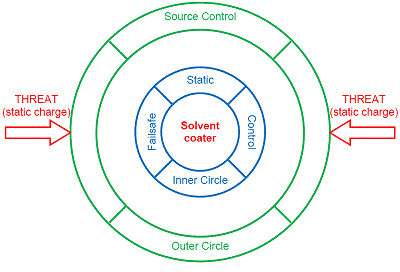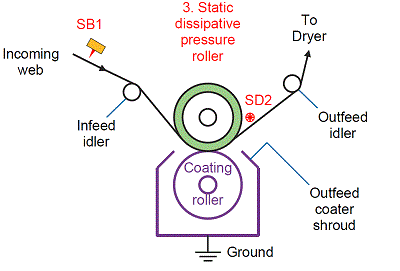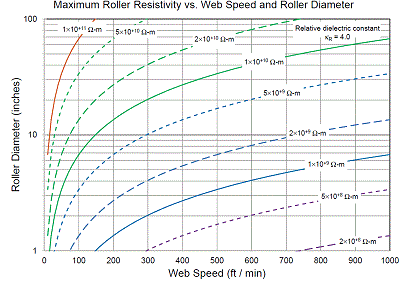Static Beat | Solvent Coater Static Control for Insulating Webs
- Published: November 06, 2014, By Kelly Robinson
Sparks are bad. Static sparks can release enough electrical energy to ignite flammable solvent vapors so solvent coaters must be well protected from static. Sparks near the solvent gravure coater in Figure 1 are suppressed by two layers of static protection.

The solvent coater in Figure 1 is protected by a fault tolerant static control system. The “outer circle” devices dissipate static at sources of static charging. When these devices are functioning properly, a charge free web enters the solvent coater. The “inner circle” devices suppress sparks should there be a failure or fault in the outer circle of protect. With two layers of protection, sparks occur in the protected solvent coater only where there are two simultaneous faults or failures.
The three devices protecting the solvent coater in Figure 2 are in the “best practice” locations. When the outer circle devices are functioning properly, the incoming web in Figure 2 is charge free. The first device, static bar SB1, is the inner circle device that suppresses sparks in the solvent coater from static charges on the incoming web that are present only when there is an upstream failure or fault.

Static bar SB1 can face either the uncoated side or the coated side of the web. Normally, static dissipators should always be installed facing the charged web surface. In this case, either surface could be charged depending on where the upstream failure occurs. In Figure 2, I’ve shown SB1 facing the uncoated side so that it faces downward (to minimize airborne contamination) and so that the in-feed web protects it from splashes of coating solution from the coater. These precautions lengthen the service life of the static bar. However, install SB1 on your coater facing the web surface that is best or most convenient for your operation.
The second device, static dissipator SD2, is an outer circle, source control device needed to protect the solvent coater from static charge deposited on the web during coating. Charge may be deposited on the web during coating by at least three mechanisms.
- Contact charging with the coating roller or with the pressure roller during normal coating operation.
- Contact charging with the coating roller or with the pressure roller when the coater runs dry (coating failure).
- Charges deposited on the web by an electrostatic assist for coating system.
When the web in Figure 2 exits the coating nip with high static charge, a spark may occur between the charged web and the nearest grounded, conducting object. If the nearest grounded object is the outfeed coater shroud in Figure 2, the spark from the charged web to the coater shroud may ignite flammable solvent vapors near the coater. To prevent this spark, static dissipator SD2 must the nearest grounded object on the outfeed side of the coater. Since the coater area is often congested, I recommend that SD2 be a passive dissipator such as an ionizing cord or an ionizing rod. These devices are small and they can be located conveniently on the outfeed side close to the nip where the web exits the pressure roller.
The third device protecting the solvent coater in Figure 2 from static sparks is the static dissipative pressure roller. In many coaters, a polymer-covered pressure roller presses the web against the coating roller. Just like every nip, tribocharging occurs when the uncoated web surface touches the polymer surface of the pressure roller, and this charge separates when the web exits the pressure roller. While static charges on web are neutralized by dissipator SD2, we must dissipate the static charges on the surface of the pressure roller.
In normal operation, the pressure roller establishes the coating nip by pressing the web against the coating roller. As the roller turns, static charges accumulate on the surface of the polymer pressure roller. If this surface is insulating, the static level builds until a spark occurs to the nearest grounded object, which may be the coating roller, the liquid coated layer on the web exiting the coating nip, or the metal core of the pressure roller.
We must dissipate the static charges on the pressure roller surface to prevent sparks. I recommend using a static dissipative polymer coating on the pressure roller. This coating should have a volumetric resistivity that is low enough so that static can dissipate within one roller revolution [see K. Robinson, “Fault Tolerant Static Control,” AIMCAL 2013 Web Coating and Handling Conference, October 27-30, 2013]. The maximum roller resistivity in Figure 3 varies with the web speed and the roller diameter. Lower resistivities are required for smaller rollers and for higher web speeds because the rollers turn faster leaving less time to dissipate static.

An alternative to using a static dissipative polymer on a pressure roller is to dissipate static on the roller surface using a static dissipator. While using static dissipators is practiced in our industry, static dissipators facing rollers perform poorly. In this location, static dissipators are also prone to contamination from coating solution. So, I recommend coating the pressure roller with a static dissipative polymer rather than using a static dissipator.
Sparks are bad. Sparks can release enough electrical energy to ignite flammable solvent vapors. For insulating webs, protect solvent coaters from static sparks using three devices:
- an infeed static bar
- an outfeed static dissipator
- a static dissipative pressure roller
 I invite you to ask questions about this column and to suggest future topics. My e-mail address is: Kelly.Robinson@ElectrostaticAnswers.com.
I invite you to ask questions about this column and to suggest future topics. My e-mail address is: Kelly.Robinson@ElectrostaticAnswers.com.
Static control expert Dr. Kelly Robinson, president of Electrostatic Answers, has 27+ years of experience in problem-solving and consulting. Kelly writes PFFC's Static Beat column and the Kelly on Static blog. Contact him at 585-425-8158; kelly.robinson@electrostaticanswers.com; www.electrostaticanswers.com.












